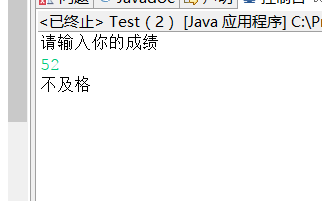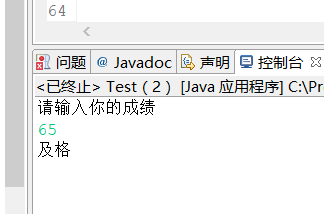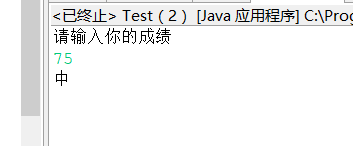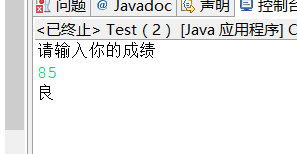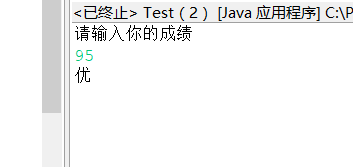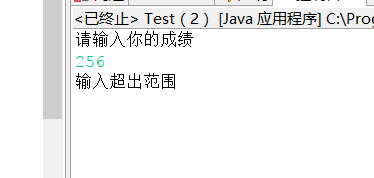异常处理,动手动脑
2017-11-16 21:10 Robortxin 阅读(125) 评论(0) 编辑 收藏 举报请阅读并运行AboutException.java示例
AboutException.java
1.import javax.swing.*;
class AboutException {
public static void main(String[] a)
{
int i=1, j=0, k;
k=i/j;
try
{
k = i/j; // Causes division-by-zero exception
//throw new Exception("Hello.Exception!");
}
catch ( ArithmeticException e)
{
System.out.println("被0除. "+ e.getMessage());
}
catch (Exception e)
{
if (e instanceof ArithmeticException)
System.out.println("被0除");
else
{
System.out.println(e.getMessage());
}
}
finally
{
JOptionPane.showConfirmDialog(null,"OK");
}
}
}

2.阅读以下代码(CatchWho.java),写出程序运行结果:
public class CatchWho {
public static void main(String[] args) {
try {
try {
throw new ArrayIndexOutOfBoundsException();
}
catch(ArrayIndexOutOfBoundsException e) {
System.out.println( "ArrayIndexOutOfBoundsException" + "/内层try-catch");
}
throw new ArithmeticException();
}
catch(ArithmeticException e) {
System.out.println("发生ArithmeticException");
}
catch(ArrayIndexOutOfBoundsException e) {
System.out.println( "ArrayIndexOutOfBoundsException" + "/外层try-catch");
}
}
}

3.出CatchWho2.java程序运行的结果
public class CatchWho2 {
public static void main(String[] args) {
try {
try {
throw new ArrayIndexOutOfBoundsException();
}
catch(ArithmeticException e) {
System.out.println( "ArrayIndexOutOfBoundsException" + "/内层try-catch");
}
throw new ArithmeticException();
}
catch(ArithmeticException e) {
System.out.println("发生ArithmeticException");
}
catch(ArrayIndexOutOfBoundsException e) {
System.out.println( "ArrayIndexOutOfBoundsException" + "/外层try-catch");
}
}
}

4.请先阅读 EmbedFinally.java示例,再运行它,观察其输出并进行总结。
public class EmbededFinally {
public static void main(String args[]) {
int result;
try {
System.out.println("in Level 1");
try {
System.out.println("in Level 2");
// result=100/0; //Level 2
try {
System.out.println("in Level 3");
result=100/0; //Level 3
}
catch (Exception e) {
System.out.println("Level 3:" + e.getClass().toString());
}
finally {
System.out.println("In Level 3 finally");
}
// result=100/0; //Level 2
}
catch (Exception e) {
System.out.println("Level 2:" + e.getClass().toString());
}
finally {
System.out.println("In Level 2 finally");
}
// result = 100 / 0; //level 1
}
catch (Exception e) {
System.out.println("Level 1:" + e.getClass().toString());
}
finally {
System.out.println("In Level 1 finally");
}
}
}
运行结果:

总结:因为有多层嵌套的finally,异常在不同的位置被接受,可能导致不同的finally语句块执行顺序。始终保持被执行。
- finally语句块一定会执行吗?
public class SystemExitAndFinally {
public static void main(String[] args)
{
try{
System.out.println("in main");
throw new Exception("Exception is thrown in main");
//System.exit(0);
}
catch(Exception e)
{
System.out.println(e.getMessage());
System.exit(0);
}
finally
{
System.out.println("in finally");
}
}
}

不会,因为有System.exit(0),而System.exit(0)可以终止程序。
6如何跟踪异常的传播路径?
当程序中出现异常时,JVM会依据方法调用顺序依次查找有关的错误处理程序。
可使用printStackTrace 和 getMessage方法了解异常发生的情况:
printStackTrace:打印方法调用堆栈。
每个Throwable类的对象都有一个getMessage方法,它返回一个字串,这个字串是在Exception构造函数中传入的,通常让这一字串包含特定异常的相关信息。
请通过 PrintExpressionStack.java示例掌握上述内容。
// Demonstrating the getMessage and printStackTrace
// methods inherited into all exception classes.
public class PrintExceptionStack {
public static void main( String args[] )
{
try {
method1();
}
catch ( Exception e ) {
System.err.println( e.getMessage() + "\n" );
e.printStackTrace();
}
}
public static void method1() throws Exception
{
method2();
}
public static void method2() throws Exception
{
method3();
}
public static void method3() throws Exception
{
throw new Exception( "Exception thrown in method3" );
}
}

请看以下代码,它们完全符合Java语法规范,但事实是它们不能通过编译:
public class TestThrows {
public static void main(String[] args) {
FileInputStream fis = new
FileInputStream("a.txt");
}
}
为什么?这是throws语句
throws语句表明某方法中可能出现某种(或多种)异常,但它自己不能处理这些异常,而需要由调用者来处理。
当一个方法包含throws子句时,需要在调用此方法的代码中使用try/catch/finally进行捕获,或者是重新对其进行声明,否则编译时报错。
8.编写一个程序,此程序在运行时要求用户输入一个整数,代表某门课的考试成绩,程序接着给出“不及格”、“及格”、“中”、“良”、“优”的结论。
要求程序必须具备足够的健壮性,不管用户输入什么样的内容,都不会崩溃
import java.util.Scanner;
public class Test {
public static void main(String[] args) {
Scanner in=new Scanner(System.in);
try {
System.out.println("请输入你的成绩");
int a=in.nextInt();
if(0<=a&&a<60)
{
System.out.println("不及格");
}
else if(60<=a&&a<70)
{
System.out.println("及格");
}
else if(70<=a&&a<80)
{
System.out.println("中");
}
else if(80<=a&&a<90)
{
System.out.println("良");
}
else if(90<=a&&a<100)
{
System.out.println("优");
}
else
{
System.out.println("输入超出范围");
}
}
catch(Exception e){
System.out.println("输入错误");
}
}
}
运行结果:
